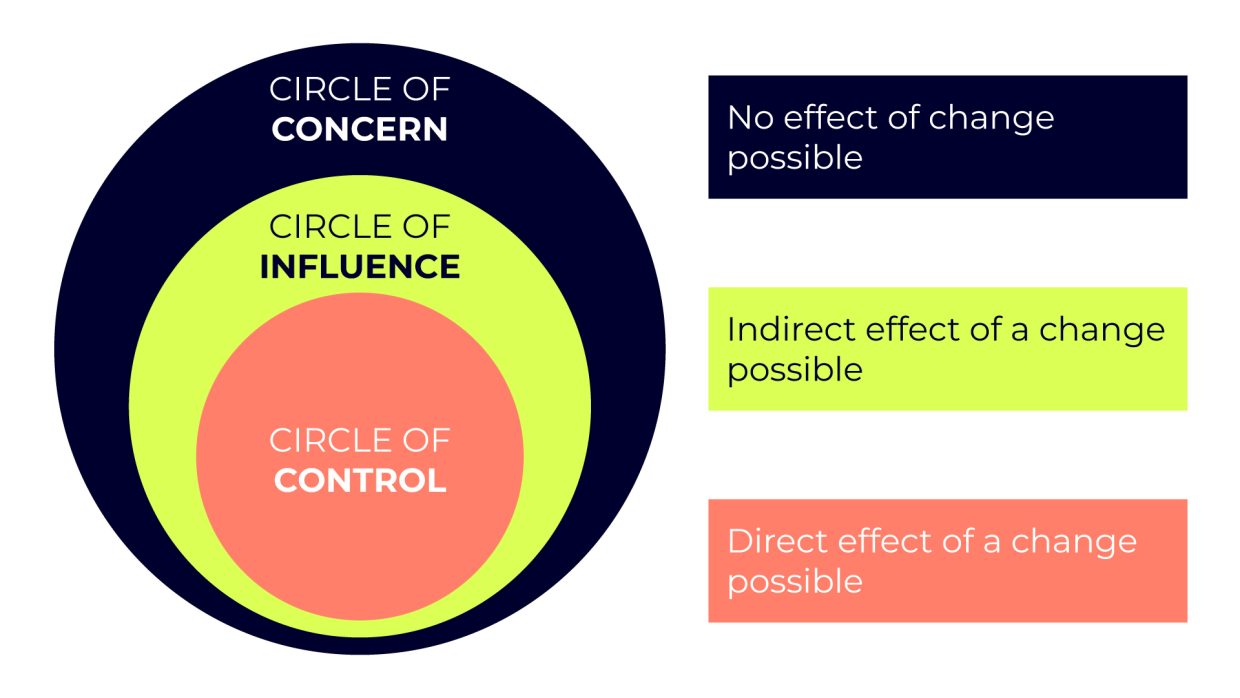We don’t know what the world of tomorrow will look like. Today, conflicts, natural disasters, delivery problems and shortages of skilled workers are shaping our news, to name just a few of the unpredictable factors that make predictability seem like a relic of a bygone era in our complex and highly interconnected world.
When uncertainties increase and familiar approaches to solutions no longer work, the central question arises: How do you remain capable of acting when planning hardly seems possible? After all, simply waiting for the challenges to solve themselves is rarely a sustainable strategy. Crises require active action – even when there are uncertainties and proven solutions are no longer effective.
Dynamic change processes are inevitably associated with imponderables – they are a typical feature of dynamic change processes. Established solutions are increasingly proving to be ineffective, while new strategies still need time to develop and establish. In this transition phase, decision-makers as well as teams and employees face complex challenges: They have to act even though the consequences of their decisions are not fully foreseeable. Relevant information for making decisions is missing and the time windows to make decisions are getting shorter. Precisely because uncertainties and unforeseeable changes are the new reality, approaches are needed that are not based on static planning, but enable dynamic adaptability. In these times, the values of the Agile Manifesto offer valuable orientation for remaining capable of acting. The values of flexibility, collaboration, and continuous adaptation must not just be abstract ideals, but should serve as guidelines so that organizations and teams can act quickly and effectively despite unforeseeable challenges.
The Agile Manifesto provides a clear framework that prioritizes flexibility and collaboration. In particular, the value of “individuals and interactions more than processes and tools” emphasizes the importance of communication and collaboration. The value of “responding to change more than following a plan” shows that we need to be flexible in responding to change.
How do you succeed in living these values in practice and not falling into passivity? The following article shows how organizations can implement these agile principles to act flexibly, proactively, and effectively.
The first step to change: Acceptance
Acceptance does not mean simply accepting a problem but taking it for granted in order to reduce inner resistance (1). It is important for the human psyche to accept situations because resistance leads to stress and exhaustion. Acceptance gives us the inner peace we need to find solutions. When we accept reality instead of resisting it, new perspectives open up and change becomes possible. Only through acceptance can we deal with impermanence and remain productive. Resistance costs energy unnecessarily, which we can better invest in solutions. Despite the many external factors that we cannot influence, there are still areas in which we can become active ourselves. The agile value “Individuals and interactions more than processes and tools” focuses precisely on this individual ability to act. It is not about letting oneself be paralyzed by external circumstances, but rather about recognizing what lies within one’s own sphere of influence and acting here.
The “Circle of Influence” is a concept that helps us to clearly distinguish which aspects we can control and which we cannot. When we focus on what we can really change – whether through small but targeted actions or by influencing our immediate environment – we ensure that we are using our energy wisely. Agility means acting flexibly and pragmatically to move forward, even when external conditions challenge us.
This approach challenges us to take responsibility and focus on solutions that we can actually implement. Because the greatest progress does not come from resistance to the unchangeable, but from active participation in what lies within our power. It is also important to recognize your own limits and to seek support when the pressure becomes too high – whether through teamwork or by working with others. In an agile environment, this means seeing yourself not only as an individual, but also as part of a team working together towards a goal.
Acknowledging our own scope for action and making a clear distinction between what we can change and what we have to accept not only helps us to remain capable of acting, but also to reduce stress and face uncertainties constructively.

Set priorities and stay focused
Being confronted with a multitude of tasks can be overwhelming and severely impair motivation. The human brain works most effectively when it can focus on manageable, concrete steps. In situations where the number of tasks seems endless, it’s crucial to prioritize and focus on what’s important. That’s where backlog prioritization comes in. It helps identify the most important and urgent tasks and work through them in a clear order.
In agile teams, it is particularly important to regularly review and adjust the topic memory. This ensures that all team members are working on the tasks that are most relevant in the current context. Setting priorities consistently prevents the team from getting lost in the flood of tasks and instead working towards the most important goals. This clear structure not only increases efficiency, but also supports motivation, as progress becomes visible, and tasks remain manageable.
Another useful approach to prioritizing is the WIP (Work in Progress) limit, which is set at 1. This guarantees that only one task is worked on at a time. This promotes concentration, reduces multitasking, and improves the quality of work. The team stays focused, stress is reduced, and progress becomes transparent. This method creates a constant flow of work that allows the team to work on tasks efficiently and with a clear structure.
Formulate goals – create clarity for targeted action
Prioritizing tasks is only successful if clear goals are defined. This is the only way to correctly assess the relevance of tasks and put them in a logical order. Setting goals is therefore an essential method for managing changes and challenges in a targeted manner. A clear idea of what needs to be achieved next makes it easier to identify priorities and ensure that everyone involved is focused on the right tasks.
Clarifying the current goals and transparently communicating the next steps contribute significantly to the resilience of an organization (2). By answering the question of priority and order of tasks, employees gain a clear understanding of what is important at the moment and how they can use their energy in a targeted manner. This gives them a feeling of security and strengthens team cohesion.
An effective means of goal setting is the use of OKRs (Objectives and Key Results). This method helps to formulate clear and ambitious objectives and to combine them with measurable results (key results). This structure allows tasks to be linked directly to the higher-level goals. Regular reviews of the OKRs ensure transparency and provide continuous orientation. This allows the team to remain flexible and adapt to change, while also working towards the most important tasks with a clear focus.
Creating perspective – understanding change as an opportunity
The perception of challenges is always individual and depends on various factors. Personal traits such as optimism or pessimism, cognitive thought patterns, past experiences, and the current emotional state influence how we deal with difficult situations. It is crucial to develop perspectives in order to see challenges not as insurmountable obstacles, but as temporary phases that we can overcome.
The ability to create perspective means drawing attention to possible positive developments and strengthening hope and motivation to survive difficult times. A clear view of realistic goals and solutions helps not to get lost in negative thought spirals. Perspectives open up the space for solutions and offer orientation, especially in uncertain and challenging times.
In the context of agility, perspective is a crucial value as it helps us to understand change not as a threat, but as an opportunity.

Take matters into your own hands! – Strengthen self-organization and self-efficacy
In uncertain times, it is crucial to act proactively and take responsibility. Self-organization and self-efficacy are central elements that reinforce each other and pave the way to successfully overcome challenges.
Self-organization means structuring tasks, time and resources in such a way that you achieve goals independently and efficiently. This makes it possible to keep track of things and plan necessary steps. Self-efficacy, on the other hand, describes confidence in one’s own ability to make a difference through one’s own actions. Those who believe in themselves realize that they can take control of the situation and bear responsibility.
A Scrum team clearly shows itself in this dynamic. A person who acts more reactively responds to requests and waits for instructions. This often leads to cost-of-delay and a lack of ownership. In contrast, a proactive person becomes active, analyzes and prioritizes requirements, and acts independently. It identifies challenges at an early stage and actively tackles them. Through this way of acting, she strengthens her self-organization and at the same time has the feeling of self-efficacy, as she achieves results through her own actions.
It’s all in the mix: A successful team needs a good balance between self-organization and self-efficacy (3). Proactive action, setting clear goals and trusting in one’s ability to overcome challenges create control and promote confidence in one’s own effectiveness (4). Every success through self-organization strengthens the feeling of being able to make a difference, which in turn increases the motivation to act in an even more structured way (5).
This interaction is the key: through self-organization we become more capable of acting, and through the experience of self-efficacy we realize how important our own actions are for success. Even setbacks are not to be understood as failures, but as valuable learning opportunities that help us to continuously improve our self-organization and self-efficacy.
Allowing feelings – using emotions as a resource
Feelings and work are often seen as two separate areas (6), but in reality, emotions cannot simply be ignored, especially in intense or challenging work phases. They influence our actions, even if we do not always perceive them directly. A protected space, such as that offered by retrospectives, in which feelings can be expressed openly, is of great importance. This space not only promotes well-being, but also helps to reduce tension and gain clarity.

By creating the opportunity to share stressful things, these emotions often lose intensity and open up space for new perspectives and solutions. Such an approach strengthens trust in the team and gives each individual the feeling of being heard and understood. This approach promotes appreciative communication and makes it possible to tackle challenges constructively. Openness, honesty and trust form the basis for moving the perspective forward again and moving forward together.
In agile teams, it is considered just as important to create space for emotional interactions as it is for factual decisions. This is where the agile value of “individuals and interactions more than processes and tools” becomes apparent, as it is about understanding and integrating people as a whole, rather than just seeing them as “functionaries” in the system.
Challenges and change are inevitable – but our response to them is in our hands. By practicing acceptance, setting clear priorities and focusing on solution-oriented action, we remain proactive even in challenging times. Agility means not only adaptability, but also awareness of one’s own sphere of influence.
If we strengthen self-organization and self-efficacy, we can not only build our individual resilience, but also grow together as a team. Clear goals, open communication and a conscious handling of emotions are decisive factors in understanding change not as an obstacle, but as an opportunity.
Ultimately, it is about not focusing on the uncontrollable, but actively shaping what is in our power. After all, those who are aware of their options for action and take responsibility not only remain flexible, but can also use crises as an impetus for sustainable development.
[1] Eifert, G. H. (2022). Akzeptanz- und Commitment-Therapie (ACT) (2., überarb. Aufl.). Hogrefe Verlag.
[2] BSI Group. (2014). BS 65000:2014 Organizational resilience – Guide to building a resilient organization. British Standards Institution.
[3] Brinkmann, B. J., & Schattenhofer, K. (2020). Erfolgreiche Teams in der Selbstorganisation. Vahlen.
[4] Bandura, A. (1997). Self-Efficacy: The Exercise of Control. W. H. Freeman and Company.
[5] Locke, E. A., & Latham, G. P. (2002). Building a practically useful theory of goal setting and task motivation. American Psychologist, 57(9), 705–717.
[6] Küpers, W., & Weibler, J. (2005). Emotionsarbeit und Burnout: Empirische Befunde und theoretische Perspektiven. In: Zeitschrift für Arbeits- und Organisationspsychologie, 49(2), 57-68.




